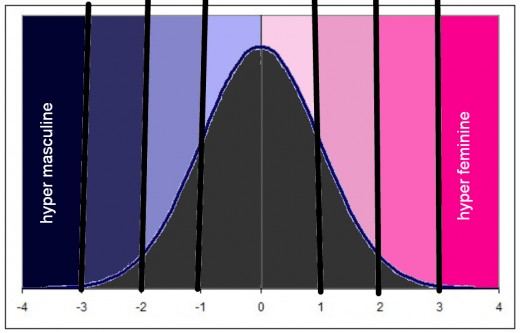Why Men Will Always Wear Panties
Some men like to wear women's clothing, we know this much for a fact. What we don't know is why or how this behavior exists. This article does not seek to definitively prove a cause for this behavior, but it does seek to put the phenomenon of men wearing women's clothing in a somewhat scientific context.
This is but a theory, a discussion point, I am not wearing a scientific coat whilst writing this, nor have I been blessed with a robe and / or wizard hat.
Hope's Men In Panties Premise: Contrary to some world views, behavior does not come in one of two categories, either male or female. Instead, behavior can be seen as falling at points along a spectrum, and the behavior expressed when men wear women's clothing is simply one form of expressing a feminine side.
Let's say that there's a scale of behavior when it comes to dressing and acting like a woman, and all men fall somewhere along it:
Hope's Impromptu Scale of Male Dress and Behavior From Feminine To Masculine:
- 3 I should have been a woman
- 2 I want to be a woman
- 1 Playing with feminine things is hot.
- 0 Feminine things make me feel very neutral.
- -1 I don't like feminine things
- -2 Feminine things make me uncomfortable.
- -3 I am intensely masculine, I sweat testosterone and lead.
The Argument:
If biology teaches us anything, its that life favors a bell curve. Why? I don't know, its one of those mathematical mysteries of life, much like the way we favor grouping events or objects in sets of three.
A Bell Curve...

This pattern can be seen representing various traits in various biological organisms. From the average weight of a Siamese cat, to the average volume of salmon spawn, biological phenomena follow this pattern. This hypothesis therefore suggests that the act of cross dressing is somehow tied to biology. It also suggests that social phenomena are subject to the law of the bell curve as much as biological phenomena.
Now, in theory, most men fall at about position 0 on the scale, feeling neither enthused nor disgusted by the idea of women's clothing. Then, as we move further to one side of the scale we find slightly fewer, but statistically significant amounts of men who enjoy the idea of flirting with things seen as being traditionally feminine. They may not be panty wearers, but they may occasionally be lead into girlish activities when in an open minded mood. Opposite them on the scale are men who don't really care about feminine things, but feel slightly uncomfortable with them and are unlikely to participate in any activity considered 'feminine'. The trends continue on both sides of the scale until we reach those men who want to become women and on the opposite side, those men who want to be supermen.
In society, our behaviors fall into bell curves quite often. We have those in the middle ground, the herd, those who go along in a pack, (wake up, sheeple!) This is where the power base usually lies. It's generally fairly wishy washy, and most of us fall into it in various ways on various issues and with our various personality traits. The outliers and those who fall elsewhere on the bell curve can have a harder time, but they are still statistically significant, to the point where politicians often target these outlying populations for political gain.
Does this mean that men in panties are doomed to remain a minority forever?
No. When it comes to social trends and morays, the bell curve can move up and down the spectrum. Japan is currently experiencing a surge in androgynous men who eschew the traditional ideas of marriage and work and instead enjoy long walks on the beach and gazing at ferns. If their population grows significantly enough, it could be sufficient to move the bell curve down the scale towards the feminine. Whether or not this is a desirable result is very much a matter of opinion, which once again, will probably fall along a bell curve.
Conclusion of the Men In Panties Hypothesis:
There will always be effeminate men, as there will always be masculine men. The acceptance and expression of these traits in any given society will vary depending on levels of personal freedom and prevailing social trends. It is unlikely that there will ever be a society in which all men dress like women or want to be women, just as it is unlikely and unrealistic that there will ever be a society where men identify as being purely masculine.
Those who maintain that there was a time when 'men were real men, and women were real women' are hearkening back to pure fantasy, or, at very best a time of very lean survival chances, where strong masculine and strong feminine traits were favored.






